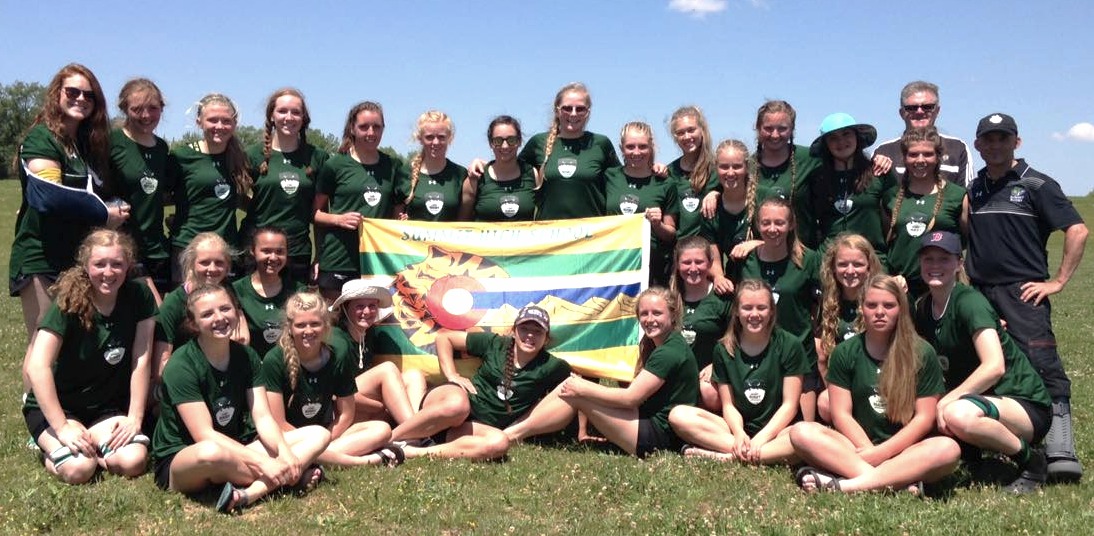
Summit’s rugby program is properly integrated into its high school. It’s treated like every other sport in terms of school support, recognition and containment to a single season (fall). There are trade-offs in terms of participating in spring fixtures, but the eight-time Colorado state champion finds ways to play and, equally as important, means to support teams that embrace the rugby school model.
Longtime Summit coach Karl Barth is a former USA U19 (now dubbed Women’s Junior All Americans) head coach, so he’s familiar with the high school landscape. The Tigers were last seen on the national stage in 2013, when the volunteer-driven invitational championship resumed after USA Rugby dropped the tournament from its championship lineup. Summit had settled into its rhythm of fall 15s, and spring 7s was becoming a good option for playing while not encroaching on the high school’s spring athletes and sports.
“If you haven’t gone in a while, you quickly realize that it’s ridiculous to try and play out of season,” Barth explained Summit’s absence from nationals. “Like always, we probably weren’t going to go [to nationals this year], but then the single-school championship came up. It was a good opportunity to promote something that we believe is the future of the game – the school model. It’s cool to play against other teams that have that extra school pride. So it was more than us just getting to go; we wanted to help promote the tournament.”
Summit couldn’t hold 15s practices until two weeks prior to the tournament. Players not involved in spring sports got creative, meeting in the wrestling room before school for 30 minutes of tackling, for example. The Tigers also competed in the Las Vegas Invitational and Atlanta Festival 7s for some field time. But the spring was laden with obstacles – from Barth tearing a ligament in his foot before the LVI and attempting to coach while non-weight-bearing, to players dropping out days before nationals, to snow falling in May.
“What else can you hurl at us,” Barth laughed. “But they rolled with it. They focused on controlling what they could control, and at the same time, I don’t think they lost sight of the fact that they could go and do well.
“We went in with the idea that we could beat anyone there and also get beat by anyone there,” the coach added. “We knew if we could stay healthy, get into midseason form fast and get the game going, then we could run with – if not beat – anyone there.”
But there were some serious obstacles to overcome in St. Charles, Mo. Juniors Natalie Gray and Jodi Losch had to lead a pack that featured backs-turned-forwards and/or teammates with little to no varsity-level game time. Most notably, junior Emily Wallace retuned to the field after sampling the sport her freshman year. She was a good center then, and after playing with the team in Atlanta, was asked to play lock. She played above expectations and even won the game ball against Catholic Memorial.
“They gave us a shot,” Barth said of the forwards. “They worked hard, didn’t get pushed around in the scrum, had good lineouts. They gave the backs a chance to do their thing and stretch the field.”
And that’s where Summit’s strength lies – in its backs. Led by the Dartmouth-bound Becca Jane Rosko at fullback, the Tigers know how to find space and attack at high speed. The fullback led throughout the weekend, turning the defense and setting up teammates like sophomore Brigid Corson for tries. She was crucial in the back field, making several try-saving tackles. Quinnipiac-bound Meg Rose and AIC commit Allyson Pothier (until her injury in the semifinals) were inspirational as always, and the quickly rising star of sophomore Cassidy Bargell was also a highlight.
“As we were playing State College, I was wondering if they’d wake up,” Bart said of the quarterfinal opener. “I was impressed with how quickly they got into game mode.
“The defense is what surprised me,” the coach continued. “If you haven’t been out in a while, usually you’re OK offensively if you can rely on a couple individuals – but not on defense. After the first half of our first game, we had three consecutive halves without a score.”
The teams entered the half tied, and then Summit pulled away in the second half for the 26-14 win. The Colorado side faced Catholic Memorial in the semifinals, and the similarly styled teams battled to out-maneuver each other.
Summit defeated the Crusaders 17-0, and then watched St. Joseph and Divine Savior Holy Angels in the other semifinal.
“Everyone watched the first half and thought: OK, cool, we’re playing Divine Savior in the final,” Barth recalled the Dashers’ 17-7 halftime lead. “And then St. Joe’s came back. They showed great fitness, incredibly good defense and were really consistent.”
The Ohio team defeated the Midwest champion 19-17 to advance to the final. In the championship match, the teams traded scores in the first half, but an extra conversion saw Summit lead 14-12 into the break. But the Tigers incurred a yellow card 30 seconds before halftime, and the Jaguars did not err in utilizing that player advantage in the second half. Two tries in 10 minutes put St. Joe up 29-14 for the win.
“At that point, there were just too many obstacles,” Barth referenced the injuries of Pothier and Rosko and the sin bin. “We were dead-even except for those 10 minutes, but the fact that we held on in that second half was nice. The players were disappointed to get that close, but all credit to St. Joe’s – they’re an impressive outfit.
“For us, we’re happy,” Barth reflected on the experience as a whole. “It was a big challenge to gear up and get here. They’re bruised and battered, but deep down, they’re happy. It’s nice sometimes to not be 100% happy because then they want a little more.”
It’s unlikely that Summit will return to the single-school national championship, even though it was a rewarding experience. Two weeks of training and then three games in a weekend is tough. However, if the single-school and club championships reunite at a single location, and the tournament is spread out across three days (like the boys’ tournament), then Summit’s victories might outweigh its trials a year from now.
#Summit SingleSchoolNationalChampionship




